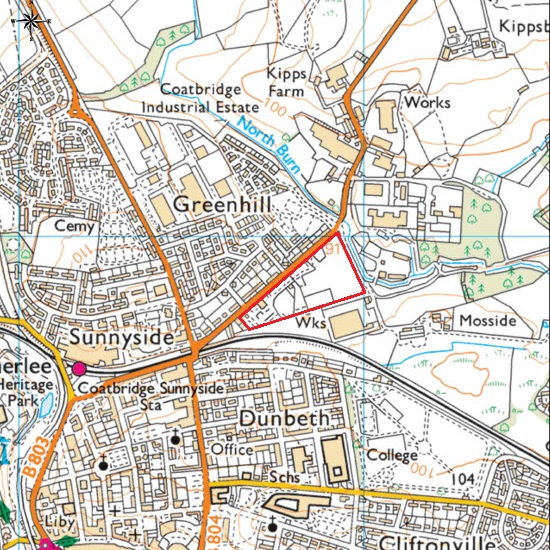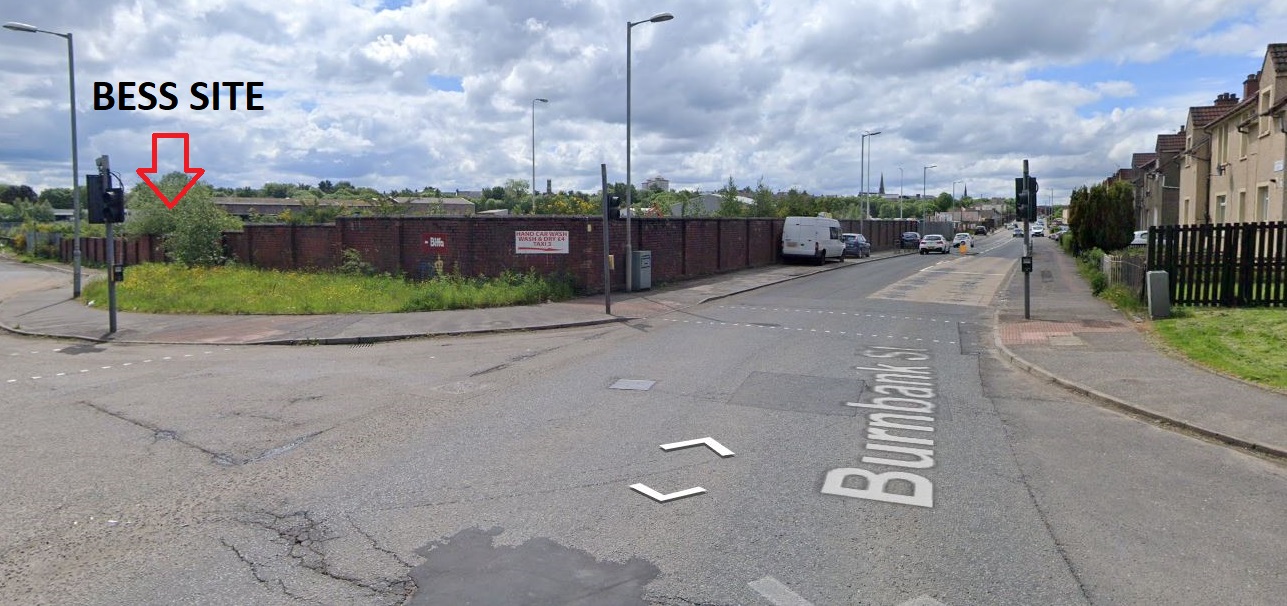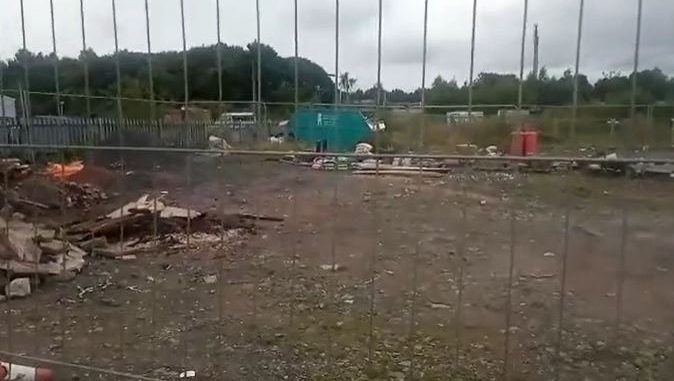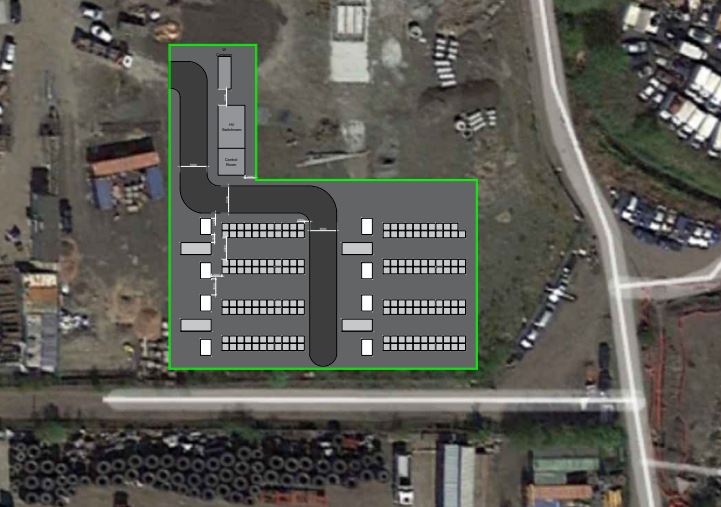BURNBANK
BATTERY STORAGE
Renewable Connections has received consent for a Battery Energy Storage System (BESS) up to 30MW at Burnbank Street, Coatbridge. Once operational, the batteries will enable energy from renewables, like solar and wind, to be stored and then released when customers need power most.
Renewable Connections undertook public consultations locally in 2021 and 2023. The project was consented by North Lanarkshire Council in August 2024.
- Battery storage has a key part to play in ensuring homes and businesses can be powered by green energy even when the sun isn’t shining, or the wind has stopped blowing.
- Batteries help manage the peaks and troughs of energy demand as supply becomes ever more challenging to achieve net zero carbon production through the phasing out of fossil fuel plants and increasing renewable energy.
- The UK government estimates technologies like battery storage systems – supporting the integration of more low-carbon power, heat and transport technologies – could save the UK energy system up to £40 billion by 2050, ultimately reducing people’s energy bills.
LOCATION
The BESS site is located to the rear of the industrial site on Burnbank Street, Coatbridge. The area is predominantly industrial on the southern side of Burnbank Street, with housing to the north. Burnbank Street provides good access to the site. Because the site is located at the rear of the industrial site it will have limited impact on the housing to the north of the street.
OUR PROPOSALS
The Battery Energy system will have a capacity of up to 30 MW (60 MW hrs) which is the equivalent to power 6,486 homes and will be operational for up to 40 years. After that time, all of the installation will be removed, and the land restored to how it was before. The power will be imported / exported to the grid via a substation connecting directly into the SP Energy Networks Coatbridge, no new pylons will be necessary to facilitate the connection.
The Batteries will be constructed using state-of-the-art lithium-ion phosphate battery technology. It will comprise of battery storage modules aligned in rows supported by transformer and invertor platforms. The maximum height of the modules will be less than 3 metres and therefore will be lower than existing structures within the industrial estate.
The transformers and invertors platforms will be connected via underground cables. The point of connection to SP Energy Coatbridge substation will be connected via underground cables. A 2m perimeter security fence and free-standing security cameras with infrared lighting pointing into the site will protect the site to ensure safety and protect the equipment.
PROJECT TIMELINE
STAGE 1
Site selection
2020 – 2021
STAGE 2
Preliminary Surveys
June – July 2021
STAGE 3
Pre-application
August 2021
STAGE 4
Virtual Community Consultation
17th November 2021
Community Consultation Events
April-May 2023
STAGE 5
Submission
January 2024
STAGE 6
Construction
2026 +
THE NEED FOR THE PROJECT
Following the Government’s declaration of an “Environment and Climate Emergency” in May 2019, the Committee on Climate Change (CCC) advised that to meet ‘Net Zero’ targets, the UK will require substantial amounts of new, low carbon power sources to be built before 2050, up to four times that of today’s levels. Energy storage systems are essential for achieving these goals and National Grid estimates that over 100 GWh of energy storage will be required to meet UK’s net zero target by 2050. There are currently approximately 4 GWh.
Battery storage, together with renewable energy generation help support Scotland’s target of 50% of energy for Scotland’s heat, transport, and electricity consumption to be supplied from renewable sources by 2030.
Renewable energy generation is intermittent and hard to predict due to the fluctuations of wind and solar. Intermittent renewable energy is challenging because it disrupts the conventional methods for planning the daily operation of the electricity grid. Fast fluctuation in wind and solar energy disrupts the balance between total energy supply and demand. BESS’s can react rapidly to sudden changes in the electricity supply and demand securing the stability of the network.
The BESS would have a capacity of up to 30 MW and be built on approximately 1 acre of land. It would optimise 100 MW of renewable energy projects around the UK to connect onto the electricity network. The project connects to the Coatbridge substation which has been identified by SP Energy as a location where a BESS would benefit the network.
Indicative Site Layout
FAQ’s
How do battery energy storage systems work?
Advanced technology battery storage systems can be charged by electricity generated from renewable energy, like wind and solar power. Intelligent battery software uses algorithms to coordinate energy production and computerised control systems are used to decide when to keep the energy to provide reserves or release to the grid. Energy is released from the battery storage system during peak demand, keeping electricity flowing and costs down.
Why not use nuclear power instead of battery storage?
Wind and solar farms are cheaper to operate than nuclear (and fossil fuels). Therefore, wind and solar can bid lower prices into electricity markets and displace nuclear from base-load operation, which it needs to pay off its huge capital costs. Nuclear reactors are not suited to working together with renewable generation due to their inflexibility they can’t react to fast changing grid fluctuations, whereas battery storage is ideally suited to balancing the grid.
Why this location?
This site has been identified following extensive site selection across North Lanarkshire which considered environmental designations, local electricity network access and capacity, the physical characteristics of the site, and a supportive landowner.
Will there be any impacts on local roads?
For a period of approximately six months during construction, there will be deliveries of equipment to site. Renewable Connections will put in place measures to manage impacts of construction traffic and these measures will be included in a Construction Traffic Management Plan that will submitted with the planning application. We work closely with the local Highways Authority to prevent damage and minimise disruption.
There will be infrequent maintenance visits to the site during operation.
Will there be any permanent impact?
BESS sites are temporary, and the land will be fully reinstated once the equipment is removed at the end of the project life.
Do batteries pose a health risk?
No – LFP batteries (or Lithium Iron Phosphate) will be used in the Burnbank Energy Storage system. LFP batteries are thermally and chemically stable, with no risk of fumes or gas leaks. They are made of abundant, non-toxic materials like iron, copper and graphite so have a lower environmental impact from mining, processing and recycling.
Are the batteries noisy?
No – the battery energy storage system will generate some low-level electrical noise from the inverter, switchgear and fans, however the noise impact for people living near the site is negligible. A noise impact assessment will be commissioned as part of the planning application submission.
Will there be any visual impact from the Storage site?
Located at the rear of the industrial site at Burnbank Street, the site will have limited visual impact in the surrounding area. Any lighting will be free-standing security cameras with infrared lighting pointing into the site itself to minimise light disruption.
How long will the project be there?
The development proposes a life span of up to 40 years. No later than this, the development would be decommissioned. A decommissioning plan will be provided with the planning submission.
GET IN TOUCH
burnbankbatterystorage@renewableconnections.co.uk
Telephone: 0800 254 5011
Burnbank Energy Centre Limited,
LDN:W,
3 Noble Street,
London,
EC2V 7EE
Renewable Connections is committed to respecting your privacy and to complying with UK data protection and privacy laws. Our privacy policy explains how we collect, use, share and protect personal information.



